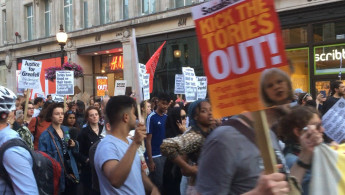Anger erupts in London as Grenfell protesters take to the streets
Protesters demand answers over catastrophic tower block tower as discontent against the UK government's austerity measures and housing policies simmers.
3 min read
Hundreds of protesters took to the streets of London on Friday to demand answers over the catastrophic blaze that tore through the Grenfell Tower housing block in west London.
Activists and local residents held demonstrations at the borough's town hall, London's Oxford Street, the UK home office, the BBC, and the prime minister's official residence at Number 10 Downing Street to vent their frustrations.
Around 800 people gathered outside Prime Minister Theresa May's residence at Downing Street to protest against the UK government's handling of the disaster, said Joey Ayoub, a journalist and activist who joined others at Number 10.
Protesters also called for Prime Minister Theresa May's resignation over the disaster, chanting "May must go" and "Justice for Greenfell", Ayoub added.
"It was a very angry crowd. There was a very clear sense of outrage that this is not ok. It should define the leadership of May and she should be forced to resign," he said.
Earlier in the day, the prime minister paid a second visit to the area around the Grenfell Tower following public outcry at her snubbing of local residents on her first visit due to "security concerns".
Her second visit ended with jeers from local residents whose frustration was confounded when the PM was quickly ushered into a car after visiting a local church where help was being organised.
The prime minister's visit sharply contrasted that of opposition leader Jeremy Corbyn, who was seen consoling the families of victims and was greeted by locals.
Protesters also stormed Kensington Town hall after officials failed to address them in person. A statement was handed to the hundreds who had gathered.
Activists and local residents held demonstrations at the borough's town hall, London's Oxford Street, the UK home office, the BBC, and the prime minister's official residence at Number 10 Downing Street to vent their frustrations.
Around 800 people gathered outside Prime Minister Theresa May's residence at Downing Street to protest against the UK government's handling of the disaster, said Joey Ayoub, a journalist and activist who joined others at Number 10.
Protesters also called for Prime Minister Theresa May's resignation over the disaster, chanting "May must go" and "Justice for Greenfell", Ayoub added.
"It was a very angry crowd. There was a very clear sense of outrage that this is not ok. It should define the leadership of May and she should be forced to resign," he said.
Earlier in the day, the prime minister paid a second visit to the area around the Grenfell Tower following public outcry at her snubbing of local residents on her first visit due to "security concerns".
Her second visit ended with jeers from local residents whose frustration was confounded when the PM was quickly ushered into a car after visiting a local church where help was being organised.
|
|
The prime minister's visit sharply contrasted that of opposition leader Jeremy Corbyn, who was seen consoling the families of victims and was greeted by locals.
Protesters also stormed Kensington Town hall after officials failed to address them in person. A statement was handed to the hundreds who had gathered.
The statement from the Royal Borough of Kensington and Chelsea promised that those affected would be housed "as locally as we can" and that funds are being released to help victims.





 Follow the Middle East's top stories in English at The New Arab on Google News
Follow the Middle East's top stories in English at The New Arab on Google News


